SHAOLIN WAHNAM SPARRING METHODOLOGY

Sifu Wong demonstrating to Emiko and Michael some finer points in combat
Training to Apply Kungfu Skills and Techniques to Sparring and Fighting
It is sad that today most kungfu practitioners cannot use their kungfu forms effectively for sparring or fighting even though some of them may be formidable fighters using techniques borrowed from other martial systems like Karate and Kickboxing. It is incredible, if not ridiculous, that some modern kungfu masters do not even believe that kungfu can be used for fighting.
Even a casual look at kungfu records, in text or in pictures, can readily show the effectiveness of kungfu for combat. In the late 19th and early 20th centuries, many masters from numerous countries went to China to test whether kungfu was combat effective. Records show that without an exception all these challengers were convincingly defeated.
For example, as recently as 80 years ago, the Shaolin master Sifu Wang Zi Ping defeated challengers from Russia, America, Japan and Germany. The Russian challenger he defeated in 1918 at the Central Park in Bejing was nicknamed “the world's strongest man”. And just 35 years ago, the Taijiquan master from Malaysia, Sifu Wong Sheng Yen, defeated an international wrestling champion half his age. Did these great masters use techniques borrowed from Karate, Kickboxing or any other martial arts? Of course not; they used genuine, traditional Shaolin Kungfu and Taijiquan.
Citing these examples is not meant to show the superiority of kungfu over other martial arts, but is meant to jerk many kungfu practitioners from their inferiority complex that their art is incapable for combat. On the other hand, we in Shaolin Wahnam do not glorify fighting, though we firmly believe that kungfu, regardless of its style, is highly combat efficient.
To be combat efficient in kungfu, it is necessary to undergo methodical training in sparring. Merely practicing kungfu forms or going straight into free sparring is a sure way to make you fight like children, throwing all your kungfu skills and techniques to the winds. Let us take an analogy from swimming. Merely performing swimming techniques on land, or going straight into water to swim, without undergoing methodical training in swimming, you would be drown when thrown into water.
In the past, all kungfu schools or styles had their own sparring methodologies, but these methodologies are generally lost today. We in Shaolin Wahnam are extremely lucky to have preserved our sparring methodology, and have found it effective from our own experience. Sifu Anthony Korahais gives a clear explanation of our Shaolin Wahnam Sparring Methodology here. We are ready to share our sparring methodology with those who are interested, regardless of whether they want to practice our Shaolin Wahnam arts.
Some of our video clips are arranged into a coherent system as follows to show how we train sparring. We use our Shaolin Wahnam Sparring Methodology for both Shaolin Kungfu and Wahnam Taijiquan, but as we already have released a series of video clips on Taijiquan Combat Application and another on Basic Taijiquan Training, the series of video clips below on Sparring Methodology are taken from Shaolin Kungfu.
- Stance Training
- Footwork Training
- Chi Flow and Zen
- Combat Sequence Training — Part 1
- Combat Sequence Training — Part 2
- Transition from Pre-Arranged to Free Sparring — Part 1
- Transition from Pre-Arranged to Free Sparring — Part 2
- Transition from Pre-Arranged to Free Sparring — Part 3
- Sparring Practice at Shaolin Wahnam Switzerland — Part 1
- Sparring Practice at Shaolin Wahnam Switzerland — Part 2
- Free Sparring from Shaolin Wahnam England
- Combat Sequences from Dragon Style Set — Part 1
- Combat Sequences from Dragon Style Set — Part 2
- Combat Sequences from Dragon Style Set — Part 3
- Combat Sequences from Dragon Style Set — Part 4
It is significant to note that while we place much importance on combat efficiency, it is not the only reason why we train our sparring methodology devotedly. Indeed, to spend an hour a day training just to be a formidable fighter is not a wise use of time. Our sparring practice gives us many other benefits, such as being relaxed in demanding situations, making decisions correctly and quickly, sharpening our sense of awareness, enhancing physical and mental reactions, increasing vitality and agility, building comradeship, and — surprising it may be to some people — developing spiritually.
As sparring today is often associated with aggressiveness and brutality to such an extent that many martial artists, ironically, consider to be hit or kicked a few times in sparring is normal, we would emphasize that we are serious about the benefits mentioned above — not as theory, but in practical terms.
We believe that if you follow the sparring methodology correctly, you will be able to use kungfu patterns for combat, irrespective of the kungfu style you practice. This is not to say that you will always win in sparring or fighting. In other words, although you will be able to apply your typical kungfu stances and techniques to spar or fight against an opponent — and not bouncing about with borrowed techniques from other martial systems — whether you can beat him is another question. You must not forget that your opponent too has a sparring methodology.
Given the shameful situation today when many kungfu practitioners fight like children, or like Kickboxers, just being able to use kungfu for sparring is a remarkable first step to help prevent kungfu losing its essence as a martial art. This is a main reason why we share the secrets of our sparring methodology. We hope you will join us to restore the past glory of kungfu. But if you think otherwise, if you, for example, think that kungfu practitioners should fight like Boxers or Kickboxers, we respect your right to your opinion, and have no intention to argue with you. If you have any questions or comments, please raise them at the Shaolin Wahnam Virtual Kwoon and Discussion Forum.
The following video clips and their accompanying notes reveal our Shaolin Wahnam Sparring Methodology.
Stance Training
 As a video clip showing stance training in Shaolin Kungfu is not presently available, we use this video clip from a Taijiquan class. In Shaolin Kungfu, the poises called “Golden Bridge” and “Embracing the Sun” are used instead of “Carrying the Cosmos” shown in this video clip.
As a video clip showing stance training in Shaolin Kungfu is not presently available, we use this video clip from a Taijiquan class. In Shaolin Kungfu, the poises called “Golden Bridge” and “Embracing the Sun” are used instead of “Carrying the Cosmos” shown in this video clip.
“Zhang zhuang”, or stance training, is the single most widely used method to develop internal force in kungfu, including Taijiquan. Many students, however, pay only lip-service to stance training, not understanding or appreciating its importance.
In this video clip, Sifu Wong explains to course participants at a regional Taijiquan class in Costa Rica in February 2005 how to move from a Horse-Riding Stance (using the poise called “Carrying the Cosmos”) to a Bow-Arrow Stance, paying careful attention to principles like “differentiating yin-yang” and “moving from the waist”.
Click here to enter.
Footwork Training

The training methodologies we use in Shaolin Wahnam are quite different from those in most other kungfu schools. In most other schools students start their kungfu career by learning kungfu sets. In Shaolin Wahnam we start with basics like stances, footwork and chi flow.
This video clip taken at random during the Intensive Shaolin Kungfu Course in Malaysia in November 2004 shows students practicing various ways of moving in the Bow-Arrow Stance and different ways to advance with their front foot.
Click here to enter.
Chi Flow and Zen

In Shaolin Wahnam, every movement in Shaolin Kungfu and Wahnam Taijiquan is a training of energy and mind. In other works, Shaolin Kungfu and Wahnam Taijiquan are always practiced as chi kung and meditation. This video clip taken at random during the Intensive Shaolin Kungfu Course in Malaysia in November 2004 at the completion of a footwork training session provides an example.
In Shaolin Wahnam, footwork training is also a training of energy and mind. At the end of a footwork training session at the course, students went into chi flow and standing meditation. Sifu Wong is seen encouraging Ismael from Ecuador to flow with the chi. The chi flow movement here is described poetically as “Yew Foong Pai Lau” (Cantonese pronunciation), or “Flowing Breeze and Swaying Willows”, an important kungfu term that is sometimes heard but rarely understood. Sifu Darryl Collett of Scotland, however, is seen enjoying a vigorous and interesting chi flow.
Click here to enter.
Combat Sequence Training — Sequences 5 to 8

It is sad that most kungfu practitioners today cannot apply their kungfu forms for sparring or real fighting. Of course kungfu can be used for fighting, although even some kungfu masters today, ironically, think that it cannot be.
What is the secret to kungfu sparring or fighting? Different schools would have different sparring methodologies. The one we use in Shaolin Wahnam is explained by Sifu Anthony Korahais in the webpage here.
This video clip shows Mark and Simon, both assistant instructors of Shaolin Wahnam England, practicing the fourth step, “Continuation”, of this sparring methodology, using Combat Sequences 5 to 8. The movements here are pre-arranged.
Click here to enter.
Combat Sequence Training — Sequences 9 to 12
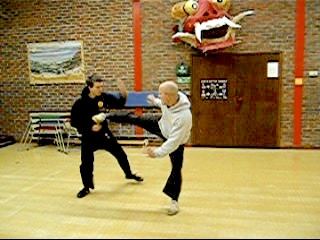
Some of those who watched Mark and Simon spar in the video clip Combat Sequence Training — Sequences 5 to 8 may wonder why they did not use any kicks. The reason was that that combat training session was meant to train hand attacks and defences. Then, how would one defend against kicks? A student at this stage would not be able to do so effectively because he has not been trained yet. Training in kicking attacks and defences is in the next stage, Combat Sequences 9 to 12, as shown in this video clip. Here, as in the earlier Combat Sequences 5 to 8, all the moves are pre-arranged.
Can these students defend themselves if their opponents attack them randomly? Not likely because again they have not been trained yet. Random attacks and defences will be trained at a later stage. Such stage by stage progression is a key factor in systematic combat training, which will eventually lead to effective free sparring and real fighting. Going straight to free sparring without systematic preparation is a sure way to fight like children.
Click here to enter.
Transition from Pre-Arranged to Free Sparring — Part 1
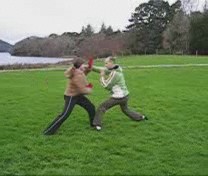
Many martial art students today make a big mistake thinking that free sparring is the way, often the only way, to learn how to fight. In all kungfu history, this was not so. Going straight to free sparring without systematic preparation is a sure way to fight like children. There are a few progressive steps between set practice and free sparring. Pre-arranged sparring as shown by Mark and Simon in Combat Sequences 5 to 8 and Combat Sequences 9 to 12 is one of these steps.
Having familiarized themselves with the appropriate skills and techniques to meet typical combat situations, students progress to a series of transitional stages where control over pre-arranged patterns is gradually released. One effective method we use in Shaolin Wahnam to achieve this purpose is what we call “Addition and Subtraction”, as shown in this video clip taken impromptu when Nicky and Hubert (both from Shaolin Wahnam England) practiced sparring on a windy winter morning by the side of beautiful Lake Killanary in Ireland in February 2005.
Is the sparring free or pre-arranged? It depends on the stage of development. The method can be programmed to range from totally pre-arranged at a beginners' stage to totally free at an advanced stage. This video clip shows the beginners' stage, where only some of the movements are free.
Click here to enter.
Transition from Pre-Arranged to Free Sparring — Part 2
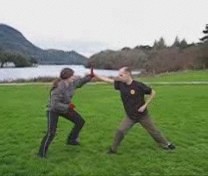
This impromptu video clip shows Nicky and Hubert practice sparring on a windy, winter morning in Ireland in February 2005. Is their sparring free or pre-arranged? It is neither, or either. Nicky and Hubert are in the process of transition from pre-arranged to free sparring. At the stage shown in the video clip, about 70% of their sparring is pre-arranged and 30% free. It is a progression from the stage shown in Part 1 in another video clip where only about 10% is free.
Systematically releasing the control of random movements is a key factor in training students to free spar or fight effectively using typical kungfu skills and techniques. The training method used here, called “Addition and Subtraction” by us in Shaolin Wahnam, is excellent for this purpose. It overcomes two big problems faced by many kungfu practitioners, namely how to implement a series of selected techniques efficiently as an attacker, and how to defend against or counter a series of attacks coming at you randomly as a defender. Nicky and Hubert are doing remarkably well here. They have practiced Shaolin Kungfu for only nine months!
Click here to enter.
Transition from Pre-Arranged to Free Sparring — Part 3
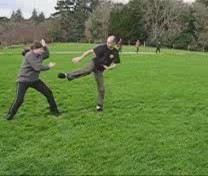
In this video clip Nicky and Hubert have progressed further in their transition from pre-arranged to free sparring. Not only they have increased the percentage of random movements, they also have added kicking attacks. Those who are familiar with our Shaolin Wahnam Combat Sequences will notice that the kungfu patterns chosen for sparring in Part 1 are from Sequences 1 to 4, those in Part 2 from Sequences 1 to 8, and those in this video clip, Part 3, from Sequences 1 to 12.
Notice that Nicky uses a correct kicking attack, but her spacing is incorrect. Hubert rightly suggests that a side kick, rather than a thrust kick, would be more effective in that situation, and later he attempts one too. Hubert's kicking attack as well as his second one later on are random moves.
It is worthy of note that Nicky is more efficient in her counter against Hubert's side kick the second time than the first, confirming that when you have worked out a counter once, subsequent counters to similar attacks would be easier, which is an important principle underlying systematic combat training.
Click here to enter.
Sparring Practice at Shaolin Wahnam Switzerland — Part 1
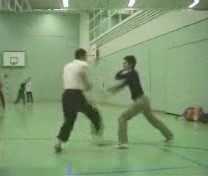
This is a sparring session at Shaolin Wahnam Switzerland, taught by Sifu Andrew Barnett. Those who have seen a few of our video clips on sparring may wonder why they look similar, regardless of whether they were taken in Switzerland, Ireland, Canada, Germany, Costa Rica or elsewhere. The answer is straight-forward. Of course they are similar because they all come from the Shaolin Wahnam Sparring Methodology.
In fact this reflects an important point we have been advocating, i.e. those trained in kungfu should spar or fight using kungfu, not using Karate, Kickboxing or any other martial arts. To go a step deeper, those trained in Shaolin Kungfu or Taijiquan would spar or fight using Shaolin Kungfu or Taijiquan, not using Pak Mei Kungfu or Baguazhang. To go even deeper, those trained in Shaolin Wahnam (whether in Shaolin or Taijiquan) would spar or fight using the skills and techniques learnt in Shaolin Wahnam.
This leads to another question. Can those trained in other schools or systems benefit from watching video clips on Shaolin Wahnam Sparring Methodolgy? Of course they can. They may, for example, apply the principles explained or shown on our video clips to their own styles or systems. They may, for example, learn how to use their own techniques for defence, instead of merely punching and kicking wildly. The principles are the same, but the sparring will be different because they use the techniques of their own schools or systems.
Click here to enter.
Sparring Practice at Shaolin Wahnam Switzerland — Part 2
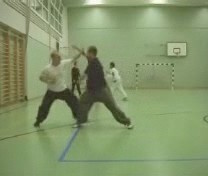
Here is another sparring session at Shaolin Wahnam Switzerland. Interestingly, this impromptu video clip filmed during a regular class taught by Sifu Andrew Barnett, exemplifies a fact that many kungfu students may have read but find it hard to believe, namely a master with internal force may floor an attacker simply by warding off his attack.
At the start of the video clip, a female student attacks Sifu Andrew Barnett with “Black Tiger Steals Heart”. Sifu Andrew Barnett responds with “Dark Dragon Draws Water”, which is found in Sequence 6 of our Shaolin Wahnam Sparring Methodolgy. Although Sifu Andrew Barnett controls his attack, the attacker falls onto the ground, not due to his attack but due to the force of her other defending hand, albeit purposely reduced under his control.
The sparring shown in this video clip is similar to that shown in other video clips. This is because the practitioners train the same type of kungfu and employ the same sparring methodology. In other words, anyone using the Shaolin Wahnam Sparring Methodolgy correctly would be able to spar like those shown in the video clips, i.e. using typical kungfu techniques and skills — and not using Kickboxing techniques or bouncing about like Boxers. Similarly anyone using an appropriate sparring methodology in Taijiquan, Hoong Ka, Wing Choon, Praying Mantis or any kungfu style would be able to spar and fight using his own style.
Such sparring methodologies were used in the past, but today they are extremely rare. So if you wish to spar using your own kungfu style, you have to find out an appropriate sparring methodology, or, albeit a poor alternative, work one out yourself. Hopefully, our video clips will provide you with some help.
Click here to enter.
Recent Free Sparring at Shaolin Wahnam UK
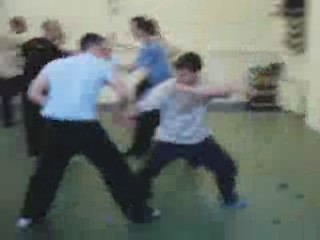
Free sparring practice by students at Shaolin Wahanm UK. The two in the foreground are Tim (left) and Gary (right). The combatants attack with only hand strikes because they have not been sufficiently trained yet to use kicks, throws and grips. A basic tenet in Shaolin Wahnam is that in combat, apply what you have been well trained.
All the students shown here have trained for about 10 months, and the techniques they use in the free sparring, where none of the movements are pre-arranged, are derived form our Shaolin Wahnam Combat Sequences 1-8. Their sparring is similar because they are at a similar level of development. As they progress they will have individual differences or preferences in their sparring as they widen or deepen their skills and techniques. Later we can see how this progression takes place as Emiko and Michael select techiques from their specialized kungfu sets for sparring.
Click here to enter.
Combat Sequences from Dragon Style Set — Part 1

How are combat sequences composed? They are composed from combat situations, and then are gradually improved upon as the exponents progress to higher levels. These series of video clips taken impromptu at the Special Shaolin Kungfu Course in Toronto in 2004 show how this happened.
This video clip shows the transition from the basic combat sequences to more sophisticated combat sequences. The sequence shown here is similar to Combat Sequences 1 to 12, except that at appropriate places Emiko and Michael use patterns from their specialized set, Dragon Style, rather than from the basic sets. For example, instead of using “Black Tiger Steals Heart” and “Single Leg Hand Sweep”, Michael uses “Green Dragon Shoots Pearl” and “Dragon Expresses Marvelous Powers” instead.
The last pattern in the video clip, “Phoenix Nods Head” is a progression, and how this comes about is revealed in another video clip.
Click here to enter.
Combat Sequences from Dragon Style Set — Part 2
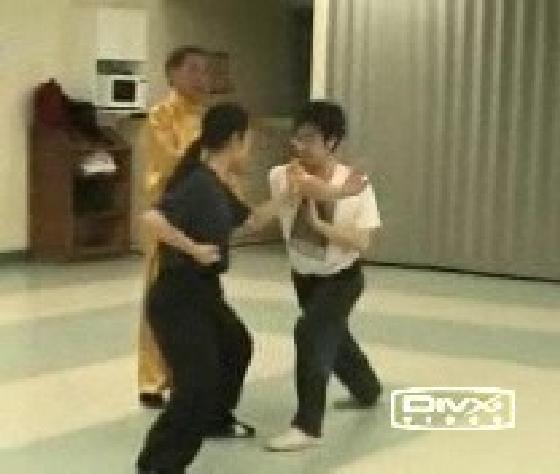
This video clip shows a progression from the previous one where Emiko and Michael incorporated patterns from their Dragon Style Set into the combat sequence. Here Sifu Wong shows Michael a more advanced way to implement the pattern “Green Dragon Shoots Pearl”, which speeds up the counter attack. This principle is expressed as “big forms for training, small forms for combat.”
Click here to enter.
Combat Sequences from Dragon Style Set — Part 3

After having used appropriate patterns to overcome various combat situations that were not pre-arranged, Emiko and Mike go over the sequence again, this time improving on their choice of patterns. Then they go over the improved sequence, which now incorporate better techniques, explaining the philosophy behind the choice of their patterns.
Sifu Wong gives his advice wherever appropriate. Here Sifu Wong shows Michael how to use a more advanced counter from the Dragon Style Set, “Phoenix Nods Head”, against Emiko's “Hang a Golden Star”. Sifu Wong also explains the two progressions involved, first using two steps then progressing to one step, which is an improvement of tactics.
Click here to enter.
Combat Sequences from Dragon Style Set — Part 4
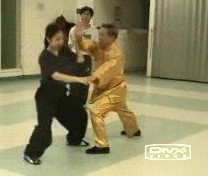
As Emiko and Michael work on the sequences, Sifu Wong shows how they can improve both the techniques as well as the tactics in combat. An example each can be found in Part 2 and Part 3 of this Dragon Style series. In this video clip Sifu Wong shows the progression from big movements in practice to small movements in combat using the pattern “Green Dragon Shoots Pearl” as an example, and how a skillful exponent may exploit the weakness of an opponent making a big movement.
Hence, by working on the combat sequences which they themselves have composed from their specialized set, Emiko and Michael have progressed remarkably from the basic level of combat sequences 1 to 16, to more advanced levels where a greater variety of skills and techniques are used.
Click here to enter.
